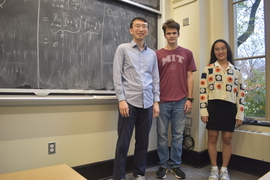The MIT math dynasty continues to break records for its performance in the annual William Lowell Putnam Mathematical Competition. For the third year in a row, MIT students corralled all five of the top Putnam Fellow spots, and for the fourth time in as many years, won the Elizabeth Lowell Putnam Prize for the top-scoring woman. In total, a striking 70 out of this year’s top 100 test-takers were MIT students, including 21 of the top 25.
In its 83rd year, the Putnam Competition is the premier mathematical competition for undergraduate students in the United States and Canada and is administered by the Mathematical Association of America (MAA). The intense six-hour exam, which features 12 proof-based math problems, was taken by 3,415 students from 456 institutions on Dec. 3, 2022. Results were announced last week.
Top honors
This year's Putnam Fellows are first-years Papon Lapate and Luke Robitaille, second-year Brian Liu, junior Mingyang Deng, and senior Daniel Zhu. Each Putnam Fellow is awarded $2,500. Zhu has placed as a fellow every year that he has competed in the exam.
The 2022 Putnam Team from MIT is (in alphabetical order) Deng, Robitaille, and Zhu. Teams are composed of the three top scorers from each participating institution. This is the MIT team’s seventh first-place win in the past nine competitions. This year, Harvard University came in second, and Stanford University third. The MIT Department of Mathematics is awarded $25,000 for being the top team, and each team member is awarded $1,000.
Junior Binwei Yan, who finished in the top 16, received the Elizabeth Lowell Putnam Prize, which includes a $1,000 award. She is the sixth MIT student to receive this honor since the award began in 1992, and the fourth in a row for MIT.
MIT students also dominated the rest of the scoreboard: nine of the next 11 (each awarded $1,000), seven of the next nine (each awarded $250), and 49 of the 75 honorable mention rankings.
Of test-takers ranked 101-200, there were 28 MIT students, and from 201-500, 47 were from MIT. In total, 145 MIT students placed in the top 500.
“Our students' outstanding performance on the Putnam is a testament to their dedication and hard work,” says Yufei Zhao, associate professor of mathematics, who prepares a group of first-year students for the competition through his Putnam Seminar. “The results of the Putnam are a source of pride for our institution and a reflection of the exceptional talent of our students.”
This year, about 180 MIT students took the exam, which consists of 12 problems worth 10 points each. The top score was 101 out of 120 points, but the average score was approximately 8.2; the median score was one.
“For all those who did not perform as they hoped, please remember Pierre de Coubertin's quote: ‘The most important thing is not winning but taking part!,’” says math department head Michel Goemans, the RSA Professor of Mathematics.
A full list of the rankings and names of the students can be found on the Putnam website.
Putnam alumni
About half of the top scorers are alumni of the MIT Math PRIMES (Program for Research in Mathematics, Engineering and Science) high school outreach program. This list includes Liu, Robitaille, and Zhu, five of the next top 11, and three out of the next nine winners, along with many of the students receiving honorable mentions.
“Every year, I see familiar names of former PRIMES students among Putnam winners,” says Pavel Etingof, a math professor who is also PRIMES’ chief research advisor. “For the second year in a row, three out of five Putnam Fellows are PRIMES alumni, all of them from MIT. PRIMES truly serves as a pipeline of mathematical talent for MIT!”
In the history of the Putnam Competition, only eight students have become Putnam Fellows all four years that they've participated, including three from MIT and a Harvard student who is now a math professor at MIT, Bjorn Poonen. Only 24 other students in the contest's history are three-time Putnam Fellows; Zhu joins six other former MIT students, including Zhao ’10, PhD ’15, who earned this honor. (Zhu was ineligible to try for four, due to the pandemic’s pause on the 2020 competition.)
Other MIT math professors who were Putnam Fellows include Davesh Maulik, Peter Shor, and David Vogan PhD ’76. One of the contributors to the competition’s problems included former Putnam coach and MIT math emeritus professor Richard Stanley, the founder of MIT’s Putnam Seminar.
MIT’s 2019 top scorers made Putnam history when all five Putnam Fellows were from one institution for the first time. The competition was founded in 1927 by Elizabeth Lowell Putnam in memory of her husband William Lowell Putnam and has been offered annually since 1938, administered by the MMA.
“No matter how well a student performs in the competition, the experience of engaging intensely with challenging problems develops the student's mathematical power and creativity,” says Putnam Mathematical Competition Director Daniel Ullman. “Kudos to every participant!”
Adds MAA Executive Director Michael Pearson, “The future of mathematics is bright because of these students, and we look forward to their continued success.”











